Gilbert Clark: How to leverage and separate a media company
Harvard scholar, Gilbert Clark, now President and CEO of Deseret News and Deseret Media Group is tasked with developing digital business that will secure the Mormon-owned company's legacy as established media declines. So far, so good: Digital revenues will exceed legacy revenues this year, even though broadcast revenue streams are trending up.
His thoughts at the 2011 Borrell Local Interactive Conference, (where he one an award as the most innovative media executive) show the theories underpinning the break out performance of Deseret Digital Media in almost all categories today.
Clark summarized his approach by outlining Borrell's study of high market share media sites.
100% of these top sites had separated the digital business unit from the legacy media in every major area including:
*P&L
*Direct Sales
*Content, product and tech teams
*Management structure
Quoting Clay Christensen, "Businesses evolve, business units don't," Clarka advocates for companies to launch separate digital business units. But he also proposed leveraging assets in editorial and sales.
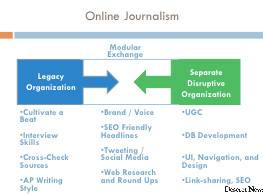
Branded content strategy produced by the new digital business unit has taken new forms.
One example is a user-generated movie review site that rates films both for how family-friendly they are (Mormon Church-owned Deseret's brand is as a national "Voice for Values), in addition to how worthwhile the movie is to see, with a user-experience that has more in common with a radio dial than a movie listing (reminding us of one top media executive who said, "If my web designer produces something that wins an award, I'll fire him").
Take a look:
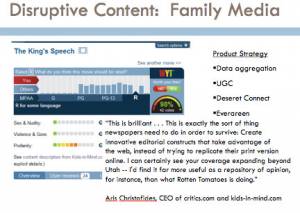
Deseret now licences this platform to other media companies.
On the commerce side, a similar strategy of leveraging, separating and innovating is going on. Legacy reps still sell print, broadcast and major accounts, and specialize in forming deep relationships. However, they are now also expected to understand the brand (ie beyond the media type), sell bundled-in digital products and services, be trained on digital marketing, and have specific web revenue targets.
However, there is new revenue-driven digital business unit that includes a direct sales force, and telemarketing, self-serve advertising and e-commerce development, all focused around new suites of products and services:
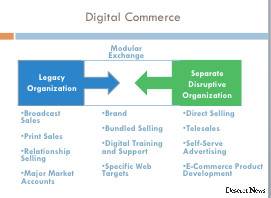
E-commerce includes travel products and a self-serve apartment management service added to classifieds.
The key to exploiting new markets - and the reason for the separate business unit - has to do with all the things outlined in the Innovator's Dilemna here . But the much larger opportunity is in tapping into new marketplaces.
The most illustrative slide of the Borrell conference is Clarks "blue versus green" division of the old and new markets, showing local media's tendency to focus on the relatively tiny amount of revenue currently being displaced rather than the new markets available. As innovators move "up-market" over time and attack established companies they hyper-focus on this small displaced area. Take a good look:
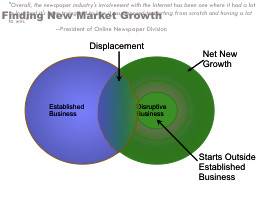
This is the key argument for a separate business unit, not to promote or avoid cannablism faster, but to capture the huge additional markets that exist. To look at some of the key digital revenue programs Deseret now has under way, case study here. But this 2011 graph clearly showed how digital would exceed traditional growth in one of the most valuable local/national brands:
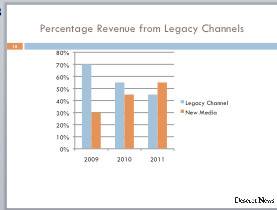
Lessons learned:
1. The key unit in the new economy is not audience, as Christensen puts it, but "jobs to be done." Understanding how people shop a marketplace, and jobs to be done is key to capturing new revenues.
For companies without the development resources of Deseret Media, there are a number of partnerships available. Too often, however, the "jobs to be done" research - even just deep focus groups - is skipped.
2. Many of Deseret's first new programs were mobile, and were able to leap frog into consumer spaces because they were developed for the market, rather than repurposed content.
3. Leveraging did not mean creating a hybrid structure, but creating separate one while evolving the original units. The final decisions need to remain with the independent business unit, with its own goals and value.
4. Looking at the world through a "blue or green lens" means that managers arrive at different questions and different answers. Clark says when he considers Google and Facebook as local competitors, the size of the actual market becomes apparent.
"I shouldn't get an award because I'm in last place."





